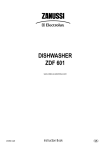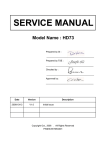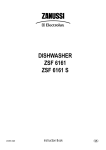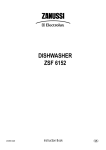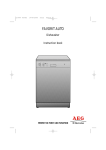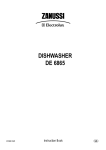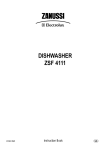Download Zanussi ZDF301 Specifications
Transcript
DISHWASHER ZDF 301 www.video.uk.electrolux.com 117995 01/0 Instruction Book UK Contents Safety instructions 3 Something not working 15 Disposal 3 Service and Spare Parts 17 Economical and ecological dishwashing 3 Customer Care Department 17 Description of the appliance 4 Guarantee Conditions 18 The control panel 5 Prior to using for the first time The water softener Filling with dishwasher salt Rinse aid 6 6 7 7 Installation instructions Fitting under a counter Levelling Water supply connections Water outlet hose connection Electrical connection 19 19 19 19 19 20 Hints for test centres 21 In daily use Loading cutlery and dishes The lower basket The cutlery basket The upper basket Adjusting the height of the upper basket Use of detergent 8 8 8 9 9 10 10 Different kinds of detergent 11 Washing programmes 12 Starting a washing programme 13 Maintenance and cleaning Cleaning the filters Prolonged periods of non-operation Frost precautions Moving the machine 14 14 14 14 14 Technical specifications Dimensions Width Height with worktop Height without worktop Max depth Max depth with open door Electrical connection: Voltage Overall power Fuse Information on the electrical connection is given on the rating plate on the inner edge of the dishwasher’s door. Water supply pressure Minimum Maximum Capacity 60 cm 85 cm 82 cm 60 cm 118.5 cm 0.05 MPa (0.5 bar) 0.8 MPa (8 bar) 12 place settings This appliance complies with the following E.E.C. Directives: - 73/23 or 19.2.73 (Low Voltage Directive) and subsequent modifications; - 89/336 or 3.5.89 (Electromagnetic Compatibility Directive) and subsequent modifications. 2 Safety instructions It is most important that this instruction book should be retained with the appliance for future reference. Should the appliance be sold or transferred to another owner, or should you move house and leave the appliance, always ensure that the book is left with the appliance in order that the new owner can get to know the functioning of the appliance and the relevant safety information. This information has been provided in the interest of your safety. You MUST read it carefully before installing or using the appliance. If you are unsure about any aspect of the information in this book, please contact our customer care department on 08705 727 727 Installation ● Check your dishwasher for any transport damage. Never connect a damaged machine. If your dishwasher is damaged, you should contact your supplier. ● For safety reasons it is dangerous to alter the specifications or attempt to modify this product in any way. ● Any electrical and plumbing work required to install this appliance should be carried out by a qualified and competent person. ● Care must be taken to ensure that the appliance does not stand on the electrical supply cable. ● ● Under no circumstances should you attempt to repair the machine yourself. Repairs carried out by inexperienced persons may cause injury or serious malfunctioning. Contact your local Service Force Centre. Always insist on genuine spare parts. Disposal Dispose of the dishwasher packaging material correctly. All packaging materials can be recycled. Plastic parts are marked with standard international abbreviations: >PE< for polyethylene, e.g. sheet wrapping material. >PS< for polystyrene, e.g. padding material (always CFCfree). >POM< for polyoxymethylene, e.g. plastic clips. The sides of the dishwasher must never be drilled to prevent damage to hydraulic components. Child safety ● This appliance is designed to be operated by adults. ● Children should not be allowed to tamper with the controls or play with the product. ● Ensure the packaging materials for this appliance are kept away from children so as to prevent the risk of injury or suffocation. Cardboard packaging is manufactured from recycled paper and should be deposited in the waste paper collection for recycling. As and when you cease to use your dishwasher and withdraw it from service, your should render it unserviceable before having it disposed of. ● The water in your dishwasher is not for drinking. Detergent residues may still be present in your machine. Keep children well away from your dishwasher when the door is open. Warning! Children at play could lock themselves in your dishwasher or otherwise endanger their lives. Therefore cut off the power supply cable and make the door closing device unusable to prevent children from being trapped inside. ● Keep all detergents in a safe place out of children's reach. For the disposing of the appliance please take it to a recycling centre or to your dealer who may, for a small contribution to the costs, dispose it for you. Your dishwasher in day-to-day use ● Items that are contaminated by petrol, paint, steel or iron debris, corrosive, acidic or alkaline chemicals must not be washed in this dishwasher. ● Under no circumstances should you open the door whilst the appliance is in operation, especially during the washing phase, hot water may escape. However, if the door is opened, a safety device ensures that the machine stops. ● Only use products (detergent, salt and rinse aid) specifically designed for use in dishwashers. ● Long bladed knives stored in an upright position are a potential hazard. ● Long and/or sharp items of cutlery such as carving knives must be positioned horizontally in the upper basket. ● Ensure that the door of the dishwasher is always closed when it is not being loaded or unloaded. In this way you will avoid anybody tripping over the open door and hurting themselves. ● The symbol on the product or on its packaging indicates that this product may not be treated as household waste. Instead it shall be handed over to the applicable collection point for the recycling of electrical and electronic equipment. By ensuring this product is disposed of correctly, you will help prevent potential negative consequences for the environment and human health, which could otherwise be caused by inappropriate waste handling of this product. For more detailed information about recycling of this product, please contact your local city office, your household waste disposal service or the shop where you purchased the product. Economical and ecological dishwashing When finishing loading or unloading close the door, as an open door can be a hazard. ● Do not sit or stand on the open door. ● Isolate the appliance from the power supply and turn off the water supply after use. ● This product should be serviced by an authorised service engineer, and only genuine spare parts should be used. 3 ● Ensure that the water softener is correctly adjusted. ● Do not pre-wash under running water. ● Select the wash programme to suit the nature and degree of the soiling on the dishes. ● Do not use more detergent, dishwasher salt and rinse aid than is recommended in these operating instructions and by the manufacturer of the respective product. Description of the appliance 1. Upper basket stop 2. Water hardness dial 3. Salt container 4. Detergent dispenser 5. Control panel 6. Rating plate 7. Rinse aid dispenser 8. Filters 9. Lower spray arm 10. Upper spray arm 11. Upper basket 12. Worktop IN144 4 The control panel Delay start button Start/cancel indicator light On-Off indicator light Phase indicator lights Programme selection marker Programme selector dial Programme guide Control indicator lights Start/cancel button Programme selector dial and On-Off indicator light: the selection of a washing programme occurs by Phase indicator lights: have the following meanings: turning the programme selector dial clockwise or anticlockwise, until the desired washing programme (see "Washing programmes" chart) corresponds with the programme selection marker placed on the dial (position On). The On-Off indicator light illuminates. The indicator lights of the phases foreseen for the selected programme start flashing. Wash illuminates when the washing and rinsing phases are running. Dry illuminates when the drying phase is running. End illuminates when the washing programme has ended. It also has added functions of visual signalling as: To switch off the machine turn the programme selector dial until the marker on the dial corresponds with the On-Off indicator light (position Off). The On-Off indicator light turns off. - the setting of the water softener, - intervention of an alarm due to the malfunction of the machine. With the programme selector dial it is also possible to set the level of the water softener (see specific paragraph). As soon as you select a washing programme, the phase indicator lights for that programme will start flashing. As the programme starts, the phase indicator lights turn off except for the indicator light of the phase in progress which will remain lit with a static light. "Delay Start" button: this option allows the start of the programme to be delayed by 3 hours; the corresponding indicator light illuminates. Control indicator lights: have the following meanings: "Start/Cancel" button: once a washing programme has been set, press this button to start the programme. Salt The start/cancel indicator light (placed above the button) illuminates. refilling indicator light: illuminates when the salt has run out. Rinse-Aid refilling indicator light: illuminates when the rinse aid has run out. With this button it is possible to cancel a washing programme in progress. The salt and rinse aid indicator lights are never illuminated while a washing programme is running even if filling with salt and rinse aid is necessary. 5 Prior to using for the first time Before using your dishwasher for the first time: b) Setting electronically (The dishwasher must be switched off) 1. Ensure that the electrical and water connections comply with the installation instructions The dishwasher is factory set at level 5. 2. Remove all packaging from inside the appliance 1. Keep the Start/Cancel button pressed and turn the programme selector dial clockwise until the programme selection marker corresponds with the first washing programme. The On-Off and Start/Cancel indicator lights start to flash indicating that you have activated the water softener setting function. At the same time, the End indicator light starts flashing. 3. Set the water softener 4. Pour 1 litre of water inside the salt container and then fill with dishwasher salt 5. Fill the rinse aid dispenser Note: If you want to use the "3 in 1" combi detergents, carefully read the information given in "Different kinds of detergents". The current level is indicated by the number of flashes of the End indicator light and a pause of about 5 seconds. Example: 5 flashes, pause, 5 flashes, pause, etc...= level 5 The water softener 2. To change the level, press the Start/Cancel button. Each time this button is pressed the level changes. (For the selection of the new level, see chart). The dishwasher is equipped with a water softener designed to remove minerals and salts from the water supply, which would have a detrimental or adverse effect on the operation of the appliance. The higher the content of these minerals and salts, the harder your water is. Water hardness is measured in equivalent scales, Clarke degrees, French degrees (TH°) and mmol/l (millimol per litre international unit for the hardness of water). The softener should be adjusted according to the hardness of the water in your area. Your local Water Authority can advise you on the hardness of the water in your area. Examples: If current level is 5, by pressing the Start/Cancel button once, level 6 is selected. If current level is 10, by pressing the Start/Cancel button once, level 1 is selected. The End indicator light remains off for about 5 seconds and then starts flashing indicating the new set made. 3. To memorise the operation, switch off the machine by returning the programme selector dial to the Off position, that is the programme selection marker corresponds with the On-Off indicator light. Otherwise wait for about 60 seconds, after which the dishwasher will automatically return to setting mode. The water softener must be set in both ways: manually, using the water hardness dial and electronically, using the programme selector dial and the Start/Cancel button. a) Setting manually 1. Open the dishwasher door. 2. Remove the lower basket from the dishwasher. 3. Turn the water hardness dial to position 1 or 2 (see table). 4. Replace the lower basket. The dishwasher is factory set at position 2. Adjustment of the water hardness setting Clarke °TH mmol/l manually electronically Number of flashes of the "End" indicator light 64 - 88 91 - 125 9,0 - 12,5 2 level 10 10 yes 53 - 63 76 - 90 7,6 - 8,9 2 level 9 9 yes 46 - 52 65 - 75 6,5 - 7,5 2 level 8 8 yes 36 - 45 51 - 64 5,1 - 6,4 2 level 7 7 yes 28 - 35 40 - 50 4,0 - 5,0 2 level 6 6 yes 23 - 27 33 - 39 3,3 - 3,9 2 level 5 5 yes 18 - 22 26 - 32 2,6 - 3,2 1 level 4 4 yes 13 - 17 19 - 25 1,9 - 2,5 1 level 3 3 yes 5 - 12 7 - 18 0,7 - 1,8 1 level 2 2 yes <5 <7 < 0,7 1 level 1 1 no Water hardness 6 Use of salt Filling with dishwasher salt Rinse aid Only use salt specifically designed for use in dishwashers. All other types of salt not specifically designed for use in a dishwasher, especially table salt, will damage the water softener. Only fill with salt just before starting one of the complete washing programmes. This will prevent any grains of salt or salty water, which may have been spilt, remaining on the bottom of the machine for any period of time, which may cause corrosion. Rinse aid is automatically added during the last rinse, ensuring thorough rinsing, and spot and streak free drying. The dispenser, which is positioned inside the door, holds about 110 ml of rinse aid, which is sufficient for between 16 and 40 dishwashing cycles, depending upon the dosage setting. Filling with rinse aid 1. Open the container by pressing the release button (A). 2. Add the rinse aid until the container is completely full. The maximum level for filling is indicated by "max". To fill: 1. Open the door, remove the lower basket and unscrew the cap of the salt container by turning it anticlockwise. 2. Pour 1 litre of water inside the container (this is necessary only before filling with salt for the first time). 3. Using the funnel provided, pour in the salt until the container is full. 4. Replace the cap making sure that there is no trace of salt on the screw thread or on the gasket. Ensure that the lid is closed after every refill. Clean up any rinse aid spilt during filling with an absorbent cloth to avoid excess foaming during the next wash. 5. Replace the cap tightly turning it clockwise until it stops with a click. Only use branded rinse aid for dishwashers. Never fill the rinse aid dispenser with any other substances (e.g. dishwasher cleaning agent, liquid detergent). This would damage the appliance. The salt container will require topping up periodically. You are reminded of this by the salt indicator light on the control panel which comes on when the salt has finished. The salt indicator light on the control panel can remain illuminated for 2-6 hours after the salt has been replenished, assuming the dishwasher remains switched on. If you are using salts that take longer to dissolve then this can take longer. The function of the machine is not affected. Adjusting the dose Do not worry if water overflows from the unit when filling with salt, this is quite normal. Increase the dose if there are drops of water or lime spots on the dishes after washing. According to the finish and drying results obtained, adjust the dose of rinse aid by means of the 6 position selector (position 1 minimum dosage, position 6 maximum dosage). The dose is factory set in position 4. Reduce it if there are sticky whitish streaks on the dishes or a bluish film on glassware or knife blades. Top up the rinse aid when the indicator light on the control panel illuminates. 7 In daily use ● Check if it’s necessary to refill with dishwasher salt or rinse aid ● Load cutlery and dishes into the dishwasher. ● Fill with dishwasher detergent . ● Select a wash programme suitable for the cutlery and dishes. ● Start the wash programme. Loading cutlery and dishes Sponges, household cloths and any object that can absorb water may not be washed in the dishwasher. ● Before loading the dishes, you should: - Remove all left over food and debris. - Soften remnants of burnt food in pans ● When loading the dishes and cutlery, please note: - Dishes and cutlery must not impede the rotation of the spray arms . - Load hollow items such as cups, glasses, pans, etc. with the opening downwards so that water cannot collect in the container or a deep base. - Dishes and items of cutlery must not lie inside one another, or cover each other. - To avoid damage to glasses, they must not touch. - Lay small objects in the cutlery basket. ● Plastic items and pans with teflon have a tendency to retain water drops; these items will not dry as well as porcelain and steel items. For washing in the dishwasher the following cutlery/dishes are of limited suitability: are not suitable: - Cutlery with wooden, horn, china or mother-of-pearl handles - Only wash stoneware in the dishwasher if it is specifically marked as being dishwasher-safe by the manufacturer. - Plastic items that are not heat resistant - Glazed patterns may fade if machine washed frequently - Older cutlery with glued parts that are not temperature resistant - Silver and aluminium parts have a tendency to discolour during washing. Residues, e.g. egg white, egg yolk and mustard often cause discolouring and staining on silver. Therefore always clean left-overs from silver immediately, if it is not to be washed straight after use. - Bonded cutlery items or dishes - Pewter or copper items - Lead crystal glass - Some types of glass can become dull after a large number of washes - Steel items prone to rusting - Wooden platters - Items made from synthetic fibres The two rows of prongs on the lower basket can be easily lowered to allow you to load pots, pans and bowls. Open the door and slide out the baskets to load the dishes. The lower basket The lower basket is designed to take saucepans, lids, plates, salad bowls, cutlery etc. Serving dishes and large lids should be arranged around the edge of the basket, ensuring that the spray arms can turn freely. 8 The cutlery basket The upper basket Long bladed knives stored in an upright position are a potential hazard. Long and/or sharp items of cutlery such as carving knives must be positioned horizontally in the upper basket. Take care when loading or unloading sharp items such as knives. The upper basket is designed for plates (dessert plates, saucers, dinner plates of up to 24 cm in diameter), salad bowls, cups and glasses. Arrange items on and underneath the cup racks so that water can reach all surfaces. Glasses with long stems can be placed upside down in the cup racks. For taller items, the cup racks can be folded upwards. Light items (plastic bowls etc.) must be loaded in the upper basket and arranged so they do not move. Forks and spoons should be placed in the removable cutlery basket with the handles facing downwards and the knives with their handles facing upwards. If the handles protrude from the bottom of the basket, obstructing the lower spray arm, load the cutlery with the handles facing upwards. Mix spoons with other cutlery to prevent them from sticking together. For best results we recommend you to use the cutlery grids provided (if the size and dimensions of the cutlery allow it). The cutlery basket is in two parts which can be separated to give greater loading flexibility. To separate the two parts, slide them horizontally in opposite directions and pull them apart. To reassemble, reverse the procedure. In case that plates are loaded in the upper basket: load them starting from the rear positions of the basket; tilting them slightly forwards and avoiding the front positions near the door. Before closing the door, ensure that the spray arms can rotate freely. 9 Adjusting the height of the upper basket Use of detergent If washing very large plates you can load them in the lower basket after moving the upper basket to the higher position. Only use detergents specifically designed for use in dishwashers. We recommend the use of Finish detergents. Maximum height of the dishes in upper basket lower basket With upper basket raised 20 cm 31 cm With upper basket lowered 24 cm 27 cm Using no more than the correct amount of detergent contributes to reducing pollution. Please observe the manufacturer’s dosing and storage recommendations as stated on the detergent packaging. To move to the higher position proceed as follows: Fill with detergent 1. If the lid is closed: press release button (1). The lid springs open. 1. Move the front runner stops (A) of the upper basket outwards and slide the basket out. 2. Fill the detergent dispenser (2) with detergent. The marking indicates the dosing levels: 20 = approximately 20 g of detergent 30 = approximately 30 g of detergent 2. Refit the basket in the higher position and replace the stops (A) in their original position. When the basket is in the higher position you will not be able to use the cup rack(s). After loading your machine always close the door, as an open door can be a hazard. 3. All programmes with prewash need an additional detergent dose (5/10 g) that must be placed in the prewash detergent chamber (3). This detergent will take effect during the prewash phase. 4. Close the lid and press until it locks in place. 10 Different kinds of detergent Detergent tablets Use of "3 in 1" combi detergents Detergent tablets from different manufactures dissolve at different rates. For this reason, some detergent tablets do not attain their full cleaning power during short washing programmes. Therefore please use long washing programmes when using detergent tablets, to ensure the complete removal of detergent residuals. These products are detergents with a combined cleaning, rinsing and salt function. 1. Check whether these detergents are suitable for your water hardness. Follow the manufacturers instructions. NOTE: the refilling of the salt container and the rinse aid dispenser are no longer necessary. In this case the rinse aid indicator light will always remain illuminated when the machine is switched on. Concentrated detergent Modern detergents for dishwashers are almost exclusively lowalkaline concentrated detergents with natural enzymes in tablet form. 2. Select the lowest setting for water hardness. 3. Before the start of the washing programme put the "3 in 1" detergent in the detergent dispenser. Using 50°C washing programmes in conjunction with these concentrated detergents reduces pollution and is good for your dishes, as these washing programmes are specially matched to the dirt-dissolving properties of the enzymes in concentrated detergents. It is for this reason that using 50°C washing programmes in conjunction with concentrated detergents can achieve the same cleaning results that can otherwise only be achieved using 65°C washing programmes. NOTE: If the drying results are not satisfactory we recommend that you: 1. Fill up the rinse aid dispenser with rinse aid. 2. Set the rinse aid dosage to position 2. If you decide to turn back to the use of the standard detergent system we advise that you: ● Fill up the dispensers for salt and rinse aid again. ● Adjust the water hardness setting to the highest setting and perform up to 3 normal washing programmes without loading any dishes. ● Adjust the water hardness setting according to the hardness of the water in your area. ● Adjust the rinse aid dosage. NOTE: When using 4 in 1 detergents that integrate also antiglass corrosion agent into "3 in 1" formula, please follow the same instruction as given for "3 in 1" detergents above. EASY POURING PACK N EW TION DOUBLE AC FOR A BRILLIANT RILLIANT SHINE L I Q U I D G E L P O W D E R RINSE C O N C E N T R AT E D D I S H WA S H E R D E T E R G E N T 11 Washing programmes Programme Degree of soil and type of load Position of the programme selector dial Cycle description (2) Consumption values Programme duration (in minutes) Energy consumption (in kWh) Water consumption (in litres) A Hot prewash Main wash up to 70°C 2 warm rinses 1 hot rinse Drying 85 - 95 1,7 - 1,9 23 - 25 Normal 65° Normal soil. Crockery and cutlery B Cold prewash Main wash up to 65°C 2 warm rinses 1 hot rinse Drying 108 - 118 1,7 - 1,8 24 - 26 Quick Wash 60° Light soil Crockery and cutlery C Main wash up to 60°C 1 hot rinse 25 - 35 0,7 - 0,8 8 (1) Economy 50° Normal soil. Crockery and cutlery D Cold prewash Main wash up to 50°C 1 cold rinse 1 hot rinse Drying 150 1,05 16 Intensive 70° Heavy soil. Crockery, cutlery, pots and pans (1) Testing programme for EN 50242 (see "Hints for Test Centres"). This programme, developed for the use of detergents with enzymes, allows you to achieve, with reduced consumption of energy the same cleaning results that would otherwise be obtained only with the 65°C programmes and conventional detergents. To compensate the lower temperature, the duration of washing and drying have been extended. (2) The consumption values are intended as a guide and depends on the pressure and the temperature of the water and also by the variations of the power supply. 12 Starting a washing programme 1. Check that the baskets have been loaded correctly and that the spray arms can rotate freely 5. To interrupt or cancel a washing programme in progress Interrupt or cancel a washing programme in progress ONLY if it’s absolutely necessary. Attention! Hot steam may escape when the door is opened. Open the door carefully. 2. Turn on the water tap Interrupt a washing programme in progress 3. Close the dishwasher door Open the dishwasher door; the programme will stop. Close the door; the programme will start from the point at which it was interrupted. 4. Setting and starting the programme Cancel a washing programme in progress Press the Start/Cancel button for about 5 seconds. The Start/Cancel indicator light turns off and the phase indicator lights are flashing. The running programme has been cancelled and it is now possible to set a new washing programme. If a new washing programme is to be selected, check that there is detergent in the detergent dispenser. Turn the programme selector dial until the marker on the dial corresponds with the desired programme (see "Washing programmes" chart). The On-Off indicator light illuminates. The indicator lights of the phases foreseen for the programme start flashing. Press the Start/Cancel button, the programme starts automatically and the Start/Cancel indicator light illuminates. 6. End of the washing programme The indicator light of the phase in progress is illuminated. The dishwasher will stop automatically. NOTE: during the running of the programme, it is not possible to change the selection made by positioning the programme selector dial in correspondence of another programme. If you want to change the running washing programme you must cancel the selection made (see "To cancel a washing programme in progress"). The illumination of the End indicator light indicates that the programme has ended. Switch off the dishwasher by returning the programme selector dial to the Off position. The On-Off indicator light turns off. Open the dishwasher’s door, leave it ajar and wait a few minutes before removing the dishes; in this way they will be cooler and the drying will be improved. Set the "Delay Start" of a programme: Once the washing programme has been set, press the Delay Start button. The corresponding indicator light illuminates. Press the Start/Cancel button, the countdown of the delay start begins automatically. 7. Unloading the dishwasher Hot dishes are sensitive to knocks. The dishes should therefore be allowed to cool down before removing from the appliance. The indicator lights of the phases turn off. The opening of the door will not modify or interrupt the countdown. Once the delay start has elapsed the washing programme will start automatically, the delay start indicator light turns off and the indicator light of the phase in progress illuminates. Empty the lower basket first and then the upper one; this will avoid water dripping from the upper basket onto the dishes in the lower one. Water may appear on the sides and the door of the dishwasher as the stainless steel will eventually become cooler than the dishes. To cancel a "Delay Start" in progress Press the Start/Cancel button for about 5 seconds, the indicator lights of Start/Cancel and Delay Start buttons turn off while the indicator lights of the phases start flashing. When the washing programme has finished, it is recommended that the dishwasher is unplugged and the water tap turned off. To start the selected washing programme press the Start/Cancel button. NOTE: the washing programme or the countdown of the delay start will begin only after having pressed the Start/Cancel button. Until that moment it is possible to modify the selection made. 13 Maintenance and cleaning Clean the external surfaces of the machine and control panel with a damp soft cloth. If necessary use only neutral detergents. Never use abrasive products, scouring pads or solvent (acetone, trichloroethylene etc....). Ensure that the seals around the door, the detergent and rinse aid dispensers are cleaned regularly with a damp cloth. We recommend the use of Finish Dishwasher Cleaner every 3 months or run a 65°C wash programme without dishes using detergent. Regular use of Finish Dishwasher Cleaner cleans inaccessible parts, eliminates unpleasant food odours and helps prevent the build-up of limescale. 9. Put the filter combination in place and lock by turning the handle clockwise to the stop. During this process ensure that the flat filter does not protrude above the base of the washing compartment. Cleaning the filters NEVER try to remove the upper spray arm. Attention! Under no circumstances may the dishwasher be used without filters. Incorrect repositioning and fitting of the filters will produce poor washing results. The filters must be checked and cleaned from time to time. Dirty filters will degrade the washing result. If residues of soil have clogged the holes in the upper spray arm, remove them with a cocktail stick. Important! Before cleaning the filters ensure that the machine is switched off. 1. Open the door, remove the lower basket. 2. The dishwasher filter system comprises a coarse filter (A), a microfilter (B) and a flat filter (C). Unlock the filter system using the handle on the microfilter, and remove. Prolonged periods of non-operation If you are not using the machine for any period of time you are advised to: 1. Unplug the appliance and then turn off the water. 2. Leave the door ajar to prevent the formation of any unpleasant smells. 3. Leave the inside of the machine clean. Frost precautions Avoid placing the machine in a location where the temperature is below 0°C. If this is unavoidable, empty the machine, close the appliance door, disconnect the water inlet pipe and empty it. 3. Turn the handle about 1/4 a turn anticlockwise and remove. Moving the machine If you have to move the machine (moving house etc....): 1. Unplug it. 2. Turn the water tap off. 3. Remove the water inlet and discharge hoses. 4. Pull the machine out together with the hoses. Avoid over tilting the machine during transportation. 4. Take hold of the coarse filter (A) by the handle with the hole and remove from the microfilter (B). 5. Clean all filters thoroughly under running water. 6. Remove the flat filter (C) from the base of the washing compartment and clean both faces thoroughly. 7. Put the flat filter (C) back in the base of the washing compartment. 8. Place the coarse filter (A) in the microfilter (B) and press together. 14 Something not working Certain problems are due to the lack of simple maintenance or oversights, which can be solved with the help of the instructions given here, without calling out an engineer. Important: If you call out an engineer to a fault listed below or to repair a fault caused by incorrect use or installation a charge will be made, even if the appliance is in guarantee. ...a flashing fault code appears The dishwasher will not start or stops during operation. The intervention of an alarm is indicated by: - continuous flashing of the Start/Cancel indicator light, - a combination of flashing and pauses of the End indicator light (as described in the chart). Open the door and carry out the following suggested corrective actions. Fault code / malfunction Possible cause Solutions - continuous flashing of the "Start/Cancel" indicator light The water tap is blocked or furred with limescale. Clean the water tap. - 1 flash of "End" indicator light The water tap is turned off. Turn the water tap on. The filter (where present) in the threaded hose fitting at the water inlet valve is blocked. Clean the filter in the threaded hose fitting. The water inlet hose has not been correctly laid or it is bent or squashed. Check the water inlet hose connection. - continuous flashing of the "Start/Cancel" indicator light The sink spigot is blocked. Clean out the sink spigot. - 2 flashes of the "End" indicator light The water drain hose has not been correctly laid or it is bent or squashed. Check the water drain hose connection. Anti-flood device is activated. Close the water tap and contact the Service Force Centre. The machine does not fill with water. The dishwasher will not drain. - continuous flashing of the "Start/Cancel" indicator light - 3 flashes of the "End" indicator light Once these checks have been carried out; close the door and press the Start/Cancel button. The programme will continue from the point at which it was interrupted. If the fault code reappears contact the Service Force Centre. For other combinations of fault codes not described in the above chart, please contact your Service Force Centre. ...there are problems when operating the dishwasher Malfunction Possible cause Solutions The dishwasher door has not been properly closed. Close the door. The main plug is not plugged in. Insert the mains plug. The fuse has blown in the household fuse box. Replace the fuse. Delay start has been selected. If dishes are to be washed immediately, cancel the delay start. The whistling is not a cause for concern. Use a different brand of detergent. The programme does not start There is a whistling noise during washing 15 ...the wash results are not satisfactory The dishes are not clean ● ● ● ● ● ● ● ● The wrong washing programme has been selected. The dishes were arranged in such a way as to stop water reaching all parts of the surface. The baskets must not be overloaded. The spray arms do not rotate freely due to incorrect arrangement of the load. The filters in the base of the washing compartment are dirty or incorrectly positioned. Too little or no detergent has been used. Where there are limescale deposits on the dishes; the salt container is empty or the incorrect level of the water softener has been selected. The drain hose connection is not correct. The salt container cap is not properly closed. The dishes are wet and dull ● ● Rinse aid was not used. The rinse aid dispenser is empty. There are streaks, milky spots or a bluish coating on glasses and dishes ● Decrease rinse aid dosing. Water drops have dried onto glasses and dishes ● ● Increase rinse aid dosing. The detergent may be the cause. Contact the detergent manufacturer’s consumer care line. If after all these checks, the problem persists, contact your local Service Force Centre, quoting the model (Mod.), product number (PNC) and serial number (S.N.). This information can be found on the rating plate located on the side of the dishwasher door (see picture). So that you always have these numbers at hand, we recommend you to make a note of them here: Mod. : . . . . . . . . . . . . . . . . . . PNC : . . . . . . . . . . . . . . . . . . S.N. : . . . . . . . . . . . . . . . . . . This product should be serviced by an authorised service engineer, and only genuine spare parts should be used. Under no circumstances should you attempt to repair the machine yourself. Repairs carried out by inexperienced persons may cause injury or serious malfunctioning. Contact your local Service Force Centre. Always insist on genuine spare parts. 16 Service and Spare Parts In the event of your appliance requiring service, or if you wish to purchase spare parts please contact your local Service Force Centre by telephoning: 08705 929929 Your telephone call will be automatically routed to the Service Force Centre covering your post code area. For the address of your local Service Force Centre and further information about Service Force, please visit the website at www.serviceforce.co.uk Before calling out an engineer, please ensure you read the details under the heading "Something not working". When you contact the Service Force Centre you will need to give the following details: 1. Your name, address and post code 2. Your telephone number 3. Clear and concise details of the fault 4. The model and serial number of the appliance (found on the rating plate) 5. The purchase date Please note that a valid purchase receipt or guarantee documentation is required for in-guarantee service calls. Customer Care Department For general enquiries concerning your Zanussi-Electrolux appliance or for further information on Zanussi-Electrolux products please contact our Customer Care Department by letter or telephone at the address below or visit our website at www.zanussi-electrolux.co.uk Customer Care Department Major Appliances Zanussi-Electrolux Addington Way Luton Bedfordshire LU4 9QQ Tel: 08705 727727 (*) * calls to this number may be recorded for training purposes To buy accessories, consumables and spare parts at our online shop please visit: http://www.zanussi-electrolux.co.uk 17 Guarantee Conditions Standard Guarantee Conditions European Guarantee We, Zanussi-Electrolux, undertake that if within 12 months of the date of purchase this ZANUSSI-ELECTROLUX appliance or any part thereof is proved to be defective by reason only of faulty workmanship or materials, we will, at our option repair or replace the same FREE OF CHARGE for labour, materials or carriage on condition that: If you should move to another country within Europe then your guarantee moves with you to your new home subject to the following qualifications: ● The appliance has been correctly installed and used only on the electricity supply stated on the rating plate. ● The appliance has been used for normal domestic purposes only, and in accordance with the manufacturer’s instructions. ● The appliance has not been serviced, maintained repaired, taken apart or tampered with by any person not authorised by us. ● All service work under this guarantee must be undertaken by a Service Force Centre. ● Any appliance or defective part replaced shall become the Company’s property. ● This guarantee is in addition to your statutory and other legal rights. Exclusions This guarantee does not cover: Damage or calls resulting from transportation, improper use or neglect, the replacement of any light bulbs or removable parts of glass or plastic. ● Costs incurred for calls to put right an appliance which is improperly installed or calls to appliances outside the United Kingdom. ● Appliances found to be in use within a commercial environment, plus those which are subject to rental agreements. ● Products of Zanussi-Electrolux manufacture which are not marketed by Zanussi-Electrolux. The guarantee starts from the date you first purchased your product. ● The guarantee is for the same period and to the same extent for labour and parts as exists in the new country of use for this brand or range of products. ● This guarantee relates to you and cannot be transferred to another user. ● Your new home is within the European Community (EC) or European Free Trade Area. ● The product is installed and used in accordance with our instructions and is only used domestically, i.e. a normal household. ● The product is installed taking into account regulations in your new country. Before you move please contact your nearest Customer Care centre, listed below, to give them details of your new home. They will then ensure that the local Service Organisation is aware of your move and able to look after you and your appliance. Home visits are made between 8.30am and 5.30pm Monday to Friday. Visits may be available outside these hours in which case a premium will be charged. ● ● 18 France Senlis Germany Nurnberg +33 (0) 344 62 29 29 +49 (0) 800 234 7378 Italy Pordenone +39 (0) 434 39 4700 Sweden Stockholm +46 (0) 8 672 53 90 UK Luton +44 (0) 8705 727727 Ireland Dublin +353 (0)1 4090751 Installation instructions Any electrical and/or plumbing work required to install this appliance should be carried out by a qualified electrician and/or plumber or competent person. The water inlet hose must not be kinked, crushed, or entangled when it is being connected. Remove all packaging before positioning the machine. The dishwasher features fill and drain hoses which can be turned either to the left or the right to suit the installation by means of the locknut. The locknut must be correctly fitted to avoid water leaks. (Attention! NOT all models of dishwashers have fill and drain hoses provided with locknut. In this case, this kind of facility is not possible). The inlet hose must hang down vertically from the supply tap. If possible, position the machine next to a water tap and a drain. Fitting under a counter If the machine is connected to new pipes or pipes which have not been used for a long time, you should run the water for a few minutes before connecting the inlet hose. (kitchen worktop or sink) By removing the machine’s worktop, you can install it under a close fitting sink unit or a pre-existing top, providing the dimensions of the recess correspond to those shown in the picture. DO NOT use connection hoses which have previously been used for an old appliance. This appliance has been fitted with safety features which will prevent the water used in the appliance from returning back into the drinking water system. This appliance complies with the applicable plumbing regulations. Water outlet hose connection The end of the drain hose can be connected in the following ways: 1. To the sink outlet spigot, securing it to the underside of the work surface. This will prevent waste water from the sink running into the machine. Proceed as follows: Remove the machine’s worktop by unscrewing the two rear retaining screws, pull the worktop from the back of the machine and slide out the front slots, lifting the worktop. 2. To a stand pipe provided with vent-hole, minimum internal diameter 4 cm. The waste connection must be at a height of between 30 cm (minimum) and 100 cm (maximum) from the bottom of the dishwasher. Insert the machine after adjusting the levelling with the adjustable feet. When inserting the machine, ensure that the water inlet and drain hoses are not kinked or squashed. During all operations that involve accessibility to internal components the dishwasher has to be unplugged. Be sure that once the appliance has been installed, it is easily accessible for the service engineer in the event that a repair is required. If the dishwasher is later used as a free-standing appliance, the original worktop must be re-mounted. The plinth on free-standing appliances is not adjustable. The drain hose can face either to the right or left of the dishwasher Ensure the hose is not bent or squashed as this could prevent or slow down the discharge of water. The sink plug must not be in place when the machine is draining as this could cause the water to syphon back into the machine. If you use a drain hose extension it must be no longer than 2 metres and its internal diameter must be no smaller than the diameter of the hose provided. Levelling Good levelling is essential for correct closure and sealing of the door. When the appliance is correctly levelled, the door will not catch on either side of the cabinet. If the door does not close correctly, loosen or tighten the adjustable feet until the machine is perfectly level. Likewise the internal diameter of the couplings used for connections to the waste outlet must be no smaller than the diameter of the hose provided. Water supply connections We recommend that this dishwasher is connected to your cold water supply. Attention! Our appliances are supplied with a security device to protect against the return of dirty water back into the machine. If the spigot of your sink has a "no return valve" incorporated this can prevent the correct draining of your dishwasher. We therefore advise you to remove it. For making the connection itself, the coupling nut fitted to the machine’s supply hose is designed to screw onto a 3/4" gas thread spout. The water pressure must be within the limits given in the "Technical specifications". Your local Water Authority will advise you on the average mains pressure in your area. 19 Electrical connection WARNING: THIS APPLIANCE MUST BE EARTHED. The manufacturer declines any responsibility should this safety measure not be observed. If the plug that is fitted to your appliance is not suitable for the socket, it must be cut off and the appropriate plug fitted. Important The wires on the mains lead are coloured in accordance with the following code: Green and Yellow - Earth Blue - Neutral Brown - Live If you fit your own plug, the colours of the wires in the mains lead of your appliance may not correspond with the markings identifying the terminals in your plug. Proceed as follows: 1. Connect the Green and Yellow (earth) wire to the terminal in the plug which is marked with the letter "E" or the earth symbol or coloured green and yellow. 2. Connect the Blue (neutral) wire to the terminal in the plug which is marked with the letter "N" or coloured black. 3. Connect the Brown (live) wire to the terminal in the plug which is marked with the letter "L" or coloured red. The plug moulded onto the lead incorporates a 13amp BSI362 fuse. Only ASTA or BSI fuses should be used. The plug must not be used if the fuse cover/carrier is lost. The cover/carrier is indicated by the coloured insert at the base of the plug. A replacement cover/carrier must be obtained from your local Service Force Centre. To isolate the dishwasher from mains, remove the mains plug. Important! The plug must still be accessible after the appliance has been installed. The appliance should not be connected to the electrical supply by means of an extension cable. In case that the electrical cable has to be replaced, please contact your local Service Force Centre. Warning! A cut off plug inserted into a 13 amp socket is a serious safety (shock) hazard. Ensure that it is disposed of safely. 20 Hints for test centres Testing in accordance with EN 60704 must be carried out with appliance fully loaded and using the test programme (see "Washing programmes" chart). Test in accordance with EN 50242 must be carried out when the salt container and rinse aid dispenser have been filled with salt and rinse aid respectively and using the test programme (see "Washing programmes" chart). Load: 12 standard place settings Rinse aid setting: position 4 (Type III) Detergent dosage : 5 g + 25 g (Type B) Arrangement lower basket Arrangement upper basket Arrangement cutlery basket Cup racks: position A 21 From the Electrolux Group. The World’s No.1 choice. The Electrolux Group is the world’s largest producer of powered appliances for kitchen, cleaning and outdoor use. More than 55 million Electrolux Group products (such as refrigerators, cookers, vacuum cleaners, chain saws and lawn mowers) are sold each year to a value of approx. 14 billion USD in more than 150 countries around the world. Zanussi-Electrolux - Major Appliances Addington Way Luton Bedfordshire LU4 9QQ 07/06 Subject to change without notice © Electrolux plc 2006
























